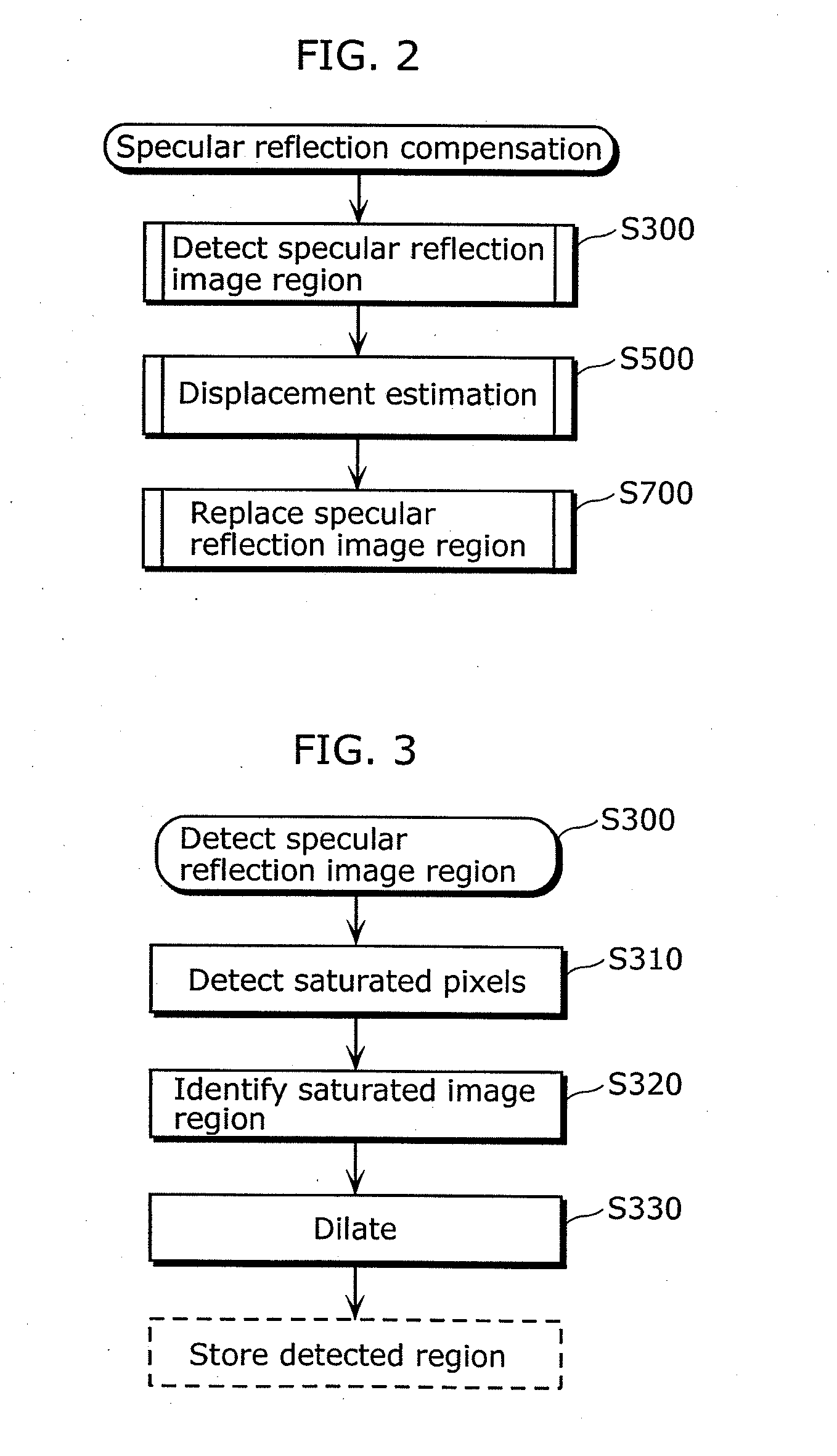Image processing method, and image processing device
a technology of image processing and processing method, applied in the field of image processing method and image processing device, can solve the problems of reducing the visibility of captured images, glare spots (bright spots) within captured images, loss of details, etc., and achieve the effect of reducing the effect of specular reflection
- Summary
- Abstract
- Description
- Claims
- Application Information
AI Technical Summary
Benefits of technology
Problems solved by technology
Method used
Image
Examples
embodiment 1
[0059]FIG. 1 shows an example of an image 100 captured using an endoscopy device (an endoscope). As can be seen in the image 100, specular reflections form rather small saturated image regions such as, regions in the area 110, 120 and 130. Consequently, there is no useful information in the positions of the specular reflections.
[0060]FIG. 2 is a flow diagram describing a method of detecting and reducing the specular reflections in a captured video sequence according to the present invention. The specular reflection reduction method of the present invention first detects a specular reflection region in the captured image (S300). In the next S500, another image or a plurality of images is searched for the regions corresponding to image regions covered by the specular reflection in the captured image. Finally, the specular reflection region in the captured image is replaced with the information from the one or a plurality of images (S700). Here, the image to be searched is an image in ...
embodiment 2
[0120]While a specular reflection region is to be replaced in Embodiment 1, a saturated region that is an image region with saturated pixel values and a false color region around the saturated region are to be replaced in Embodiment 2. The false color region is a region in which a blue false color appears around the saturated region with the saturated pixel values.
[0121]Although the following description mainly focuses on the differences with Embodiment 1, the description of the same processes as those in Embodiment 1 will be appropriately omitted.
[0122]The image to be processed in Embodiment 2 is a color image including RGB components, YUV components, or YCbCr components.
[0123]FIG. 13 is a block diagram illustrating a configuration of an image processing device according to Embodiment 2 in the present invention.
[0124]The image processing device according to Embodiment 2 includes a saturated region detecting unit 2501, a false color region detecting unit 2502, a false color compensa...
embodiment 3
[0152]According to Embodiment 2, a false color region is interpolated using a pixel value in the same image. In contrast, a false color region is interpolated using a pixel value in another image according to Embodiment 3.
[0153]Although the following description mainly focuses on the differences with Embodiments 1 and 2, the description of the same processes as those in Embodiments 1 and 2 will be appropriately omitted.
[0154]The image to be processed in Embodiment 3 is a color image including RGB components, YUV components, or YCbCr components.
[0155]FIG. 22 is a block diagram illustrating a configuration of an image processing device according to Embodiment 3 in the present invention.
[0156]The image processing device according to Embodiment 3 includes a saturated region detecting unit 2601, a false color region detecting unit 2602, a displacement estimator 2603, and a replacement unit 2604.
[0157]The saturated region detecting unit 2601 detects a pixel region (saturated region) with ...
PUM
 Login to View More
Login to View More Abstract
Description
Claims
Application Information
 Login to View More
Login to View More - R&D
- Intellectual Property
- Life Sciences
- Materials
- Tech Scout
- Unparalleled Data Quality
- Higher Quality Content
- 60% Fewer Hallucinations
Browse by: Latest US Patents, China's latest patents, Technical Efficacy Thesaurus, Application Domain, Technology Topic, Popular Technical Reports.
© 2025 PatSnap. All rights reserved.Legal|Privacy policy|Modern Slavery Act Transparency Statement|Sitemap|About US| Contact US: help@patsnap.com



